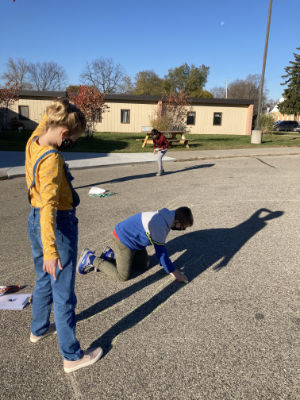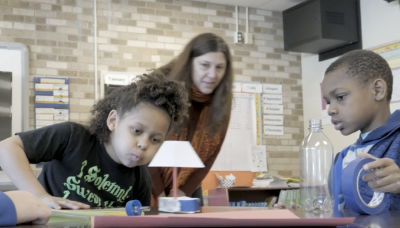Multiple Literacies in Project-Based Learning
 How can we transform elementary science teaching to support young children's opportunities to enjoy science, experience the wonders of the natural world, and learn the challenging science ideas and practices needed to make sense of the world in which they live? Never before in our society has there been such a great need to transform the teaching and learning of science so that students can use their knowledge to solve community and global problems. The ML-PBL team designed, developed, tested, and revised rigorous project-based learning units for elementary grades three through five that engage students in developing usable knowledge of science.
How can we transform elementary science teaching to support young children's opportunities to enjoy science, experience the wonders of the natural world, and learn the challenging science ideas and practices needed to make sense of the world in which they live? Never before in our society has there been such a great need to transform the teaching and learning of science so that students can use their knowledge to solve community and global problems. The ML-PBL team designed, developed, tested, and revised rigorous project-based learning units for elementary grades three through five that engage students in developing usable knowledge of science.
Principles of how students learn science and how teachers should teach anchor the ML-PBL curriculum. The teacher and student materials focus on engaging children in learning goals linked to the Next Generation of Science Standards (NGSS). Through ML-PBL curriculum experiences students explain natural events that occur in the world, design solutions to challenging engineering problems and acquire the intellectual tools to learn additional knowledge when needed. Using three-dimensional scientific knowledge – disciplinary core ideas, crosscutting concepts, and science and engineering practices – requires different instructional practices and ways of thinking about what it means to learn. The ML-PBL curriculum engages teachers in having students ask questions, plan and conduct investigations, build models, use evidence, and design, develop and share artifacts with classmates, family members, and members of their community. By developing a wide supportive community, the ML-PBL curriculum provides experiences to learners with useful feedback and knowledge-building experiences.
The ML-PBL curriculum is more than teacher and students materials; it also consists of long-term professional learning which allows teachers along with the ML-PBL researchers to form a community of learners who benefit from the experience and expertise of each other. The ML-PBL research team also designed assessment tasks that engaged learners in using the three dimensions of scientific knowledge to explain phenomena and solve problems.
 The ML-PBL team designed and tested materials iteratively over the course of the five-year project. In year four, the ML-PBL team tested the materials using a randomized control study in various regions of Michigan. The results show that 3rd-grade students who participated in ML-PBL classrooms scored 8% higher on objective summative tests designed to meet the NGSS than students who were not using the ML-PBL curriculum. What this practically means is that students in the treatment group might increase their letter grade by more than half a letter grade from a C+ to a B. The carefully designed and researched curriculum materials coupled with professional learning have allowed teachers from multiple settings to support students in developing academic and social/emotional outcomes. What is particularly noteworthy is that the positive effects hold for students of differing reading abilities, gender, and school-level race, ethnicity, and SES, and across the major geographic regions of the state. Overall, results suggest that the integration of project-based features and 3-dimensional learning along with professional learning and assessments together promote academic and social/emotional learning in science for elementary 3rd-grade students. You can download and read our full research technical report.
The ML-PBL team designed and tested materials iteratively over the course of the five-year project. In year four, the ML-PBL team tested the materials using a randomized control study in various regions of Michigan. The results show that 3rd-grade students who participated in ML-PBL classrooms scored 8% higher on objective summative tests designed to meet the NGSS than students who were not using the ML-PBL curriculum. What this practically means is that students in the treatment group might increase their letter grade by more than half a letter grade from a C+ to a B. The carefully designed and researched curriculum materials coupled with professional learning have allowed teachers from multiple settings to support students in developing academic and social/emotional outcomes. What is particularly noteworthy is that the positive effects hold for students of differing reading abilities, gender, and school-level race, ethnicity, and SES, and across the major geographic regions of the state. Overall, results suggest that the integration of project-based features and 3-dimensional learning along with professional learning and assessments together promote academic and social/emotional learning in science for elementary 3rd-grade students. You can download and read our full research technical report.
The ML-PBL curriculum was designed, developed, tested, and revised by an interdisciplinary team from Michigan State University’s CREATE for STEM Institute, with partners from the University of Michigan. This work is supported by the George Lucas Educational Foundation. The materials are made freely available under the Creative Commons Attribution Non-Commercial 4.0 license. Teachers and schools are free to use, copy, and modify them for classroom instruction.

